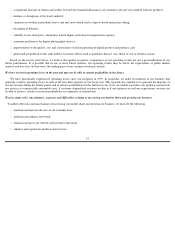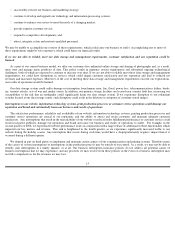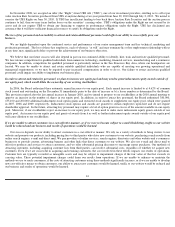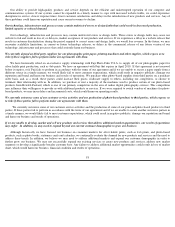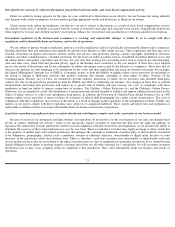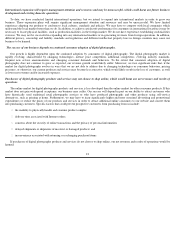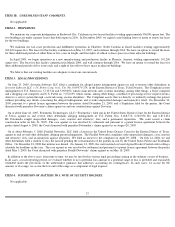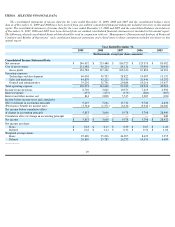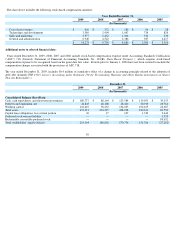Shutterfly 2010 Annual Report Download - page 22
Download and view the complete annual report
Please find page 22 of the 2010 Shutterfly annual report below. You can navigate through the pages in the report by either clicking on the pages listed below, or by using the keyword search tool below to find specific information within the annual report.
If we become involved in intellectual property litigation or other proceedings related to a determination of rights, we could incur substantial
costs, expenses or liability, lose our exclusive rights or be required to stop certain of our business activities.
Third parties may sue us for infringing their intellectual property rights. In May 2009, we settled a patent infringement suit with Parallel
Networks. In August 2009, we settled a patent infringement suit with FotoMedia Technologies, LLC. In December 2009, we settled a patent
infringement case with Soverain Software LLC. Likewise, we may need to resort to litigation to enforce our intellectual property rights or to
determine the scope and validity of third-party proprietary rights.
The cost to us of any litigation or other proceeding relating to intellectual property rights, whether or not initiated by us and even if resolved
in our favor, could be substantial, and the litigation would divert our management’
s efforts from growing our business. Some of our competitors
may be able to sustain the costs of complex intellectual property litigation more effectively than we can because they have substantially greater
resources. Uncertainties resulting from the initiation and continuation of any litigation could limit our ability to continue our operations.
Alternatively, we may be required to, or decide to, enter into a license with a third party. Any future license required under any other
party’s patents may not be made available on commercially acceptable terms, if at all. In addition, such licenses are likely to be non-
exclusive
and, therefore, our competitors may have access to the same technology licensed to us. If we fail to obtain a required license and are unable to
design around a patent, we may be unable to effectively conduct certain of our business activities, which could limit our ability to generate
revenues and harm our results of operations and possibly prevent us from generating revenues sufficient to sustain our operations.
Various governmental legal proceedings, investigations or audits may adversely affect our business and financial performance.
We may be subject to investigations or audits by governmental authorities and regulatory agencies, which can occur in the ordinary course
of business or which can result from increased scrutiny from a particular agency towards an industry, country or practice. For example, in April
2009 we and 21 other e-
commerce companies were subpoenaed to provide information related to discount programs offered by three
membership program companies, including Webloyalty Inc., one of our business partners. The resolution of such legal proceedings,
investigations or audits could require us to pay substantial amounts of money or take actions that adversely affect our operations. In addition,
defending against these claims may involve significant time and expense. Given the visibility of our brand we may regularly be involved in legal
proceedings, investigations or audits that could adversely affect our business and financial performance.
We may be subject to past or future liabilities for collection of sales and use taxes, and the payment of corporate level taxes.
Our policies concerning the collection of sales and use taxes and the payment of certain corporate level taxes have been based upon
decisions of the U.S. Supreme Court that determine when a taxpayer is deemed to have nexus with a state sufficient to impose tax obligations
under the Commerce Clause of the U.S. Constitution. Those Supreme Court decisions require that the taxpayer be physically present before a
state can require the collection of sales and use taxes. States are currently attempting to expand the definition of what constitutes physical
presence for sales and use taxes. At the same time, the standard governing the imposition of other taxes, for instance, corporate income taxes, is
less established and a number of state courts have recently concluded that the Commerce Clause definition of nexus should be expanded to
include either “physical” or “economic”
presence (essentially marketing activities) which is a broader definition than is used for sales and use
tax.
We collect sales and use taxes in jurisdictions where we have employees and/or property and in other states where we have implemented
joint sales efforts with Target Corporation.
While we believe the U.S. Supreme Court decisions support our policies concerning the collection and payment of taxes, tax authorities
could disagree with our interpretations. If sustained, those authorities might seek to impose past as well as future liability for taxes and/or
penalties. Such impositions could also impose significant administrative burdens and decrease our future sales. Moreover, the U.S. Congress has
been considering various initiatives that could limit or supersede the U.S. Supreme Court’s position regarding sales and use taxes.
20




